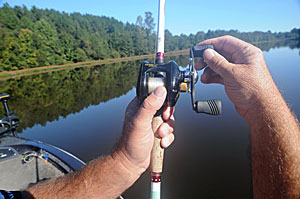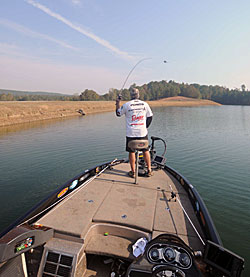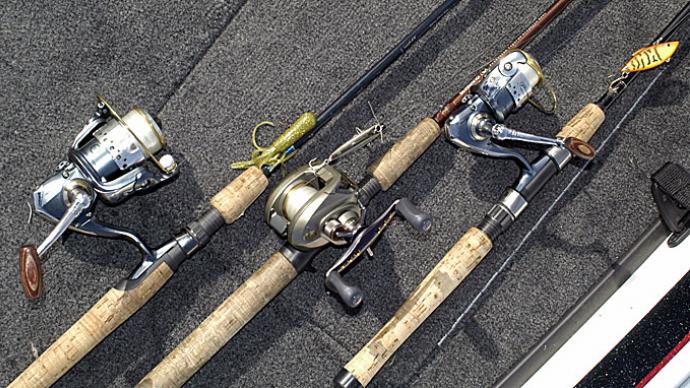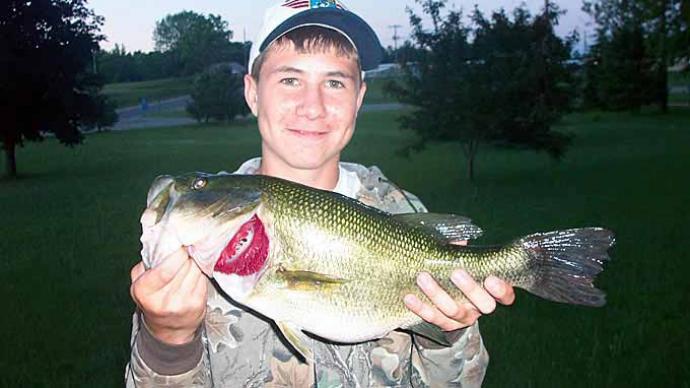
A backlash that requires lots of picking and cutting of line is one of the most frustrating situations in bass fishing.
The frustrating situation becomes compounded when an angler is just learning to use a baitcast reel while on a fishing trip. In some extreme cases, these anglers get so exasperated with the baitcaster that they never use one again.
By giving up on a baitcast reel, novices are missing out on the most effective tool for presenting their lures to bass. “It is much easier feathering your lure and getting accuracy and distance,” Bassmaster Elite Series competitor Pete Ponds says. “All three factors make the baitcaster more appealing than the spinning reel. There are times for spinning reels, and you can feather them as well, but distance and accuracy are two essential elements of the cast, and with the baitcaster, I feel like I can achieve both better than I can with the spinning reel.”
The sophisticated braking systems and anti-backlash mechanisms on today’s baitcasters make it easy for anyone to learn how to cast these reels without worrying about line overruns. Some reels have a brake dial for adjusting the centrifugal brake system, while others, such as the Ardent baitcasters Ponds uses, have internal centrifugal brake pins that need to be pulled out to engage the brakes. With plenty of practice in the correct settings, any beginner can confidently head out on the water to have a backlash-free day.
When learning how to throw a baitcaster, stay off the water because you will have the urge to start fishing. “You need to practice,” says Ponds. “You will have a frustrating day out on the lake if you have not practiced because you will spend all your time picking out backlashes. I strongly advise going to the backyard with a test weight or a practice lure and making casts.”
He also recommends practicing in an open area without trees and other obstacles that can impede your casts.
“The first objective would be to understand how the wind is blowing. If the wind blows in your face, it is much more difficult to cast than if you are throwing with the wind. Everyone has problems throwing into the wind. There are certain times when it is just hard to do.”
The next step is to find a practice plug for throwing around in the yard. “I would start with a heavier practice plug, probably around a half ounce,” suggests Ponds. “Then later, you can reduce it to a lighter weight.”
Setting up the baitcaster’s anti-backlash system is next. “On a general setup, I would pull out at least three of the centrifugal brake pins,” says Ponds. “On the right-hand side of most reels is an anti-backlash dial. I would set that up by tying my plug on and back off that dial until the lure barely starts to drop and then turn it up just a little bit from there. As you progress, you can loosen it up and also mash in one of the brakes.” Even though he is a seasoned veteran with a baitcaster, Ponds always keeps one brake pin engaged.

When delivering a cast, throw overhand with a soft touch. “Don’t try to force it out there,” Ponds warns. “Just use a smooth fluid motion whenever you make a cast.”
The Mississippi pro stresses form is most important while casting. “I tended to pull my elbow up when I tried to make a cast, so my Dad tied a rope around my waist and arm to hold my elbow down and made me cast several times. I spent days and weeks practicing casting in my backyard. I often would set up in old tire or hula hoop and try to cast it into those, and as I progressed, I would reduce the target to the size of a Coke can.”
Ponds also emphasizes patience and making sure you don’t try to throw too hard. “Distance is not the most important thing,” he says. “Accuracy is the most important thing to learn when casting. Distance will come with time. You will become more successful at catching fish if you cast accurately versus distance.
“Remember accuracy, accuracy, accuracy. It is so crucial if you want to be accurate to throw overhanded. If you are throwing sidearm, the time you let go changes the direction. You can let go less than a second later or earlier, dramatically changing the bait's position by 3 or 4 feet. “
Ponds believes that with an overhand cast, you can release the line sooner or later in the cast but can still drop the lure anywhere you want it to land by thumbing the spool. “It is also essential to always keep your eye on the lure,” says Ponds, who notes this is a key to thumbing a baitcaster. “It just comes by reflex after a while. It is much like driving a car. When you mash on the brakes, you don’t think every time that you have to mash on the brake; you just do it. It is the same thing with casting. If you train your eyes to follow your lure as it goes out there, your thumb will automatically push at the right time and apply more pressure.”
Once you have mastered casting in the backyard, you are ready to take your baitcaster out on the water and spend more time fishing rather than picking out backlashes.



